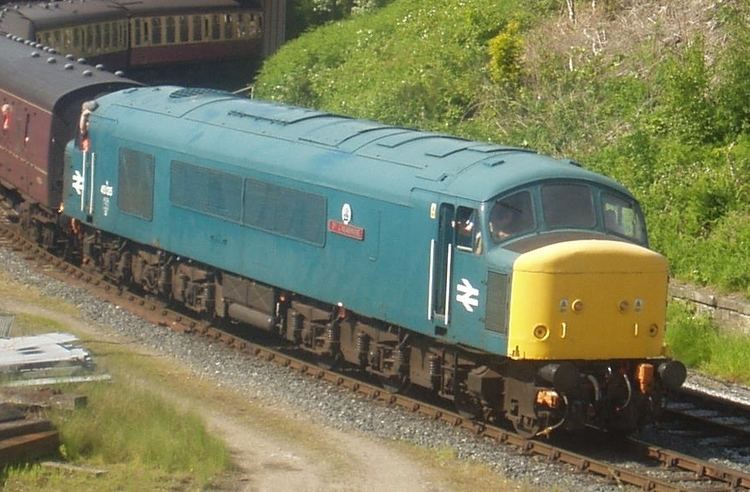Power type Diesel-electric Total produced 127 UIC class (1Co)'(Co1)' | Build date 1960–1962 Configuration 1Co-Co1 | |
 | ||
Builder British Railways' Derby Works and Crewe Works | ||
The British Rail Class 45 also known as the Sulzer Type 4 diesel locomotives were built by British Rail at their Derby and Crewe Works between 1960 and 1962. Along with the similar Class 44 and 46 locomotives, they became known as "Peaks".
Contents
History
The Class 45s became the main traction on the Midland Main Line from 1962, and their introduction allowed considerable acceleration of the previous steam-powered service. The Class 45s remained the main source of power on the Midland Main Line up to 1982, when they were relegated to secondary services following introduction of HSTs on the route. From 1986 Class 45s virtually disappeared from the line. From the early 1980s until their withdrawal c.1988, the class were regular performers on the North Trans-Pennine line working services from Liverpool Lime Street to York, Scarborough or Newcastle via Manchester Victoria, Huddersfield and Leeds. These trains were usually formed of early British Railways Mark 2 carriages, of up to seven in a typical train.
Accidents and incidents
Engine
The engine of the Class 45 was a marine-type, slow-revving diesel, a Sulzer 12LDA28B with a bore of 280 mm (11.024 in) and a stroke of 360 mm (14.173 in). This gave 22 litres (1,300 cu in) per cylinder, or 264 litres (16,100 cu in) for the whole engine. The unit was turbocharged and intercooled and gave 2,500 hp (1,900 kW) at 750 rpm. The engine was of the double bank type with two parallel banks of 6 cylinders, geared together to a single output shaft. Six-cylinder versions of the engine were fitted in the Class 25 locos (amongst others) and eight-cylinder versions in Class 33s. Class 45s were the updated versions of the Class 44 locomotives, the latter having a 2,300 hp (1,700 kW) non-intercooled version of the same engine; i.e. the 12LDA28A. The later Class 47 had a modified version of the same engine, a 12LDA28C.
Train heating
When initially put into service, the locomotives were fitted with multi-unit working and steam-heating boilers for passenger service. In the early 1970s, fifty were fitted with electric train supply in place of their steam-heating boilers and assigned to work services on the Midland Main Line from London St Pancras to Nottingham, Derby and Sheffield. These locomotives were renumbered as Class 45/1.
Auxiliary machines
The Class 45 is unusual in having a 220 volt electrical system for driving auxiliary machines and battery charging. Most British Railways diesels of the same era had 110 volt auxiliaries.
Withdrawal
The great majority of Class 45s were withdrawn between 1981 and 1988, and the last was withdrawn from service by 1989.
Preservation
Eleven locomotives survive in preservation. A quick summary of these is as follows (a more detailed study can be found in the table above):
A twelfth example, 45015, was also sold into preservation, but not restored. Withdrawn in March 1986 with a seized traction motor, for which repair was not authorised, 45015 was heavily cannibalised for spares to keep other Class 45s working. It remained at Toton, its home shed, until at least 1999. The locomotive was moved to Shackerstone, on the Battlefield Line Railway, in 2002, still with the intention of restoration to mainline standard, despite requiring a replacement engine to be found. In 2010 the host railway gave notice to the locomotive's owner that the still-unrestored 45015 needed to move to a new site. Having failed to find a buyer, it is likely that 45015 will be sold for scrap, although, as at November 2010, the derelict loco was still at Shackerstone.
